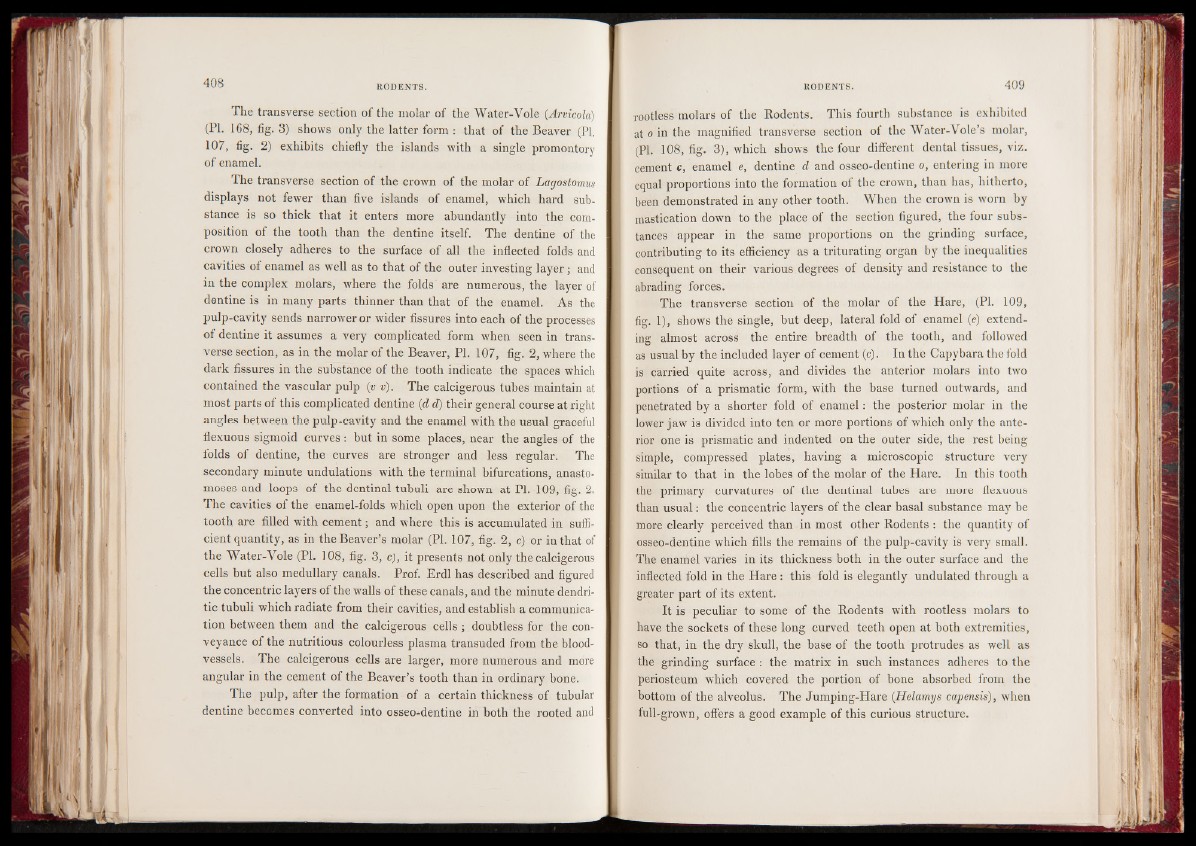
The transverse section of the molar of the Water-Vole (Arvicola)
(PI. 168, fig. 3) shows only the latter form : that of the Beaver (Pi.
107, fig. 2) exhibits chiefly the islands with a single promontory
of enamel.
The transverse section of the crown of the molar of Lagostomus
displays not fewer than five islands of enamel, which hard substance
is so thick that it enters more abundantly into the composition
of the tooth than the dentine itself. The dentine of the
crown closely adheres to the surface of all the inflected folds and
cavities of enamel as well as to that of the outer investing layer; and
in the complex molars, where the folds are numerous, the layer of
dentine is in many parts thinner than that of the enamel. As the
pulp-cavity sends narrower or wider fissures into each of the processes
of dentine it assumes a very complicated form when seen in transverse
section, as in the molar of the Beaver, PI. 107, fig. 2, where the
dark fissures in the substance of the tooth indicate the spaces which
contained the vascular pulp (r v). The calcigerous tubes maintain at
most parts of this complicated dentine (d d) their general course at right
angles between the pulp-cavity and the enamel with the usual graceful
flexuous sigmoid curves : but in some places, near the angles of the
folds of dentine, the curves are stronger and less regular. The
secondary minute undulations with the terminal bifurcations, anastomoses
and loops of the dentinal tubuli are shown at PI. 109, fig. 2,
The cavities of the enamel-folds which open upon the exterior of the
tooth are filled with cement ; and w here this is accumulated in sufficient
quantity, as in the Beaver’s molar (PI. 107, fig. 2, c) or in that of
the Water-Vole (PL 108, fig. 3, c), it presents not only the calcigerous
cells but also medullary canals. Prof. Erdl has described and figured
the concentric layers of the walls of these canals, and the minute dendritic
tubuli which radiate from their cavities, and establish a communication
between them and the calcigerous cells ; doubtless for the conveyance
of the nutritious colourless plasma transuded from the bloodvessels.
The calcigerous cells are larger, more numerous and more
angular in the cement of the Beaver’s tooth than in ordinary bone.
The pulp, after the formation of a certain thickness of tubular
dentine becomes converted into osseo-dentine in both the rooted and
rootless molars of the Rodents. This fourth substance is exhibited
at o in the magnified transverse section of the Water-Vole’s molar,
(PI. 108, fig. 3), which shows the four different dental tissues, viz.
cement c, enamel e, dentine d and osseo-dentine o, entering in more
equal proportions into the formation of the crown, than has, hitherto,
been demonstrated in any other tooth. When the crown is worn by
mastication down to the place of the section figured, the four substances
appear in the same proportions on the grinding surface,
contributing to its efficiency as a triturating organ by the inequalities
consequent on their various degrees of density and resistance to the
abrading forces.
The transverse section of the molar of the Hare, (PI. 109,
fig. 1), shows the single, but deep, lateral fold of enamel (e) extending
almost across the entire breadth of the tooth, and followed
as usual by the included layer of cement (c). In the Capybara the fold
is carried quite across, and divides the anterior molars into two
portions of a prismatic form, with the base turned outwards, and
penetrated by a shorter fold of enamel: the posterior molar in the
lower jaw is divided into ten or more portions of which only the anterior
one is prismatic and indented on the outer side, the rest being
simple, compressed plates, having a microscopic structure very
similar to that in the lobes of the molar of the Hare. In this tooth
the primary curvatures of the dentinal tubes are more flexuous
than usual: the concentric layers of the clear basal substance may be
more clearly perceived than in most other Rodents : the quantity of
osseo-dentine which fills the remains of the pulp-cavity is very small.
The enamel varies in its thickness both in the outer surface and the
inflected fold in the Hare : this fold is elegantly undulated through a
greater part of its extent.
It is peculiar to some of the Rodents with rootless molars to
have the sockets of these long curved teeth open at both extremities,
so that, in the dry skull, the base of the tooth protrudes as well as
the grinding surface : the matrix in such instances adheres to the
periosteum which covered the portion of bone absorbed from the
bottom of the alveolus. The Jumping-Hare (Helamys capensis), when
full-grown, offers a good example of this curious structure.